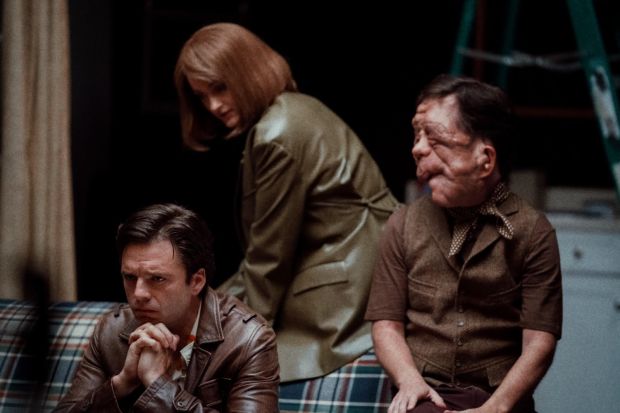The Demi Moore film “The Substance,” currently in theaters, has a doppelganger in its midst: a dark comedy likewise about an actor undergoing a radical exterior transformation while overlooking some nagging problems under the skin.
It’s called “A Different Man,” starring Sebastian Stan, and writer-director Aaron Schimberg explores ego, self-esteem, envy and desire in different and craftier ways than anything in “The Substance.” With a crucial performance from Adam Pearson to complement Stan’s fine work, the film is well worth seeing. It is, in fact, a serious joke about the act of seeing.
Edward, the gentle, forlorn aspiring actor played by Stan, lives in a New York City apartment building that conspires to drive him a little crazy. There’s a drip, drip, drip from the apartment above him, apparently from the bathroom. And there’s Ingrid, a sprightly but tough-to-read neighbor, played by Renate Reinsve, vividly unpredictable, of “The Worst Person in the World” and the recent series version of “Presumed Innocent.”
In a moment captured in a casual medium shot by the camera, Ingrid flinches at her first sight of Edward — he has neurofibromatosis, and the resulting facial tumors are a lot to process for this woman, in this miserably image-conscious culture. Soon enough, these neighbors become friendly. Edward is smitten. He presents Ingrid, a playwright, with the gift of an old typewriter, which Schimberg treats as an ongoing reminder of romantic gestures taken for granted.
Secretly, meanwhile, a medical breakthrough presents Edward with the opportunity to undergo an experimental treatment that will give him a whole new face. It works. Edward tells no one. He becomes a new person on the outside. On the inside, too; he’s more arrogant and career-driven. Unbeknownst to Ingrid, told by the new, unrecognizable Edward (now under a new identity) that Edward killed himself, the conventionally handsome newbie wins the leading role in playwright/director Ingrid’s off-Broadway play. Title? “Edward.”
From there, “A Different Man” turns into a twisty fable of malignant self-discovery. By chance, Oswald (Pearson) wanders into rehearsals one day, chatty, pleasant, curious. Like Ingrid’s fictionalized protagonist, only far more interesting, Oswald has lived with neurofibromatosis for most of his life. He has not, however, been defined or confined by it; he’s a great, game spirit, an ardent saxophonist and karaoke showoff, with many enthusiasms and a big social circle. The new Edward, struggling in rehearsals underneath a lifelike mask of his own former face, sees this interloper — Mr. Popularity — as an indictment of his own desire to be someone else.
It’s part of the film’s sardonic joke that Oswald is continually bumping into his frenemy at weird junctures, so that he becomes Edward’s Quilty, straight out of Nabokov’s “Lolita.” Schimberg’s film eventually settles for a sustained, narratively justified comeuppance, which is too bad; it sputters a bit in the last 20 minutes. But the movie has wit and never goes soft. The central trio of performers couldn’t be better, especially Pearson. He has a clarinet of a speaking voice, mellifluous and warm; on screen (he was first seen widely in Jonathan Glazer’s “Under the Skin,” nude), his exuberance is truly infectious. I’m not sure if “A Different Man” is saying anything truly new about the truly old notions of inner vs. outer beauty, or beauty standards and abnormal norms that never helped anybody. But the sly comic tone keeps us on our toes, and makes those ideas feel new.
“A Different Man” — 3.5 stars (out of 4)
MPA rating: R (for sexual content, graphic nudity, language and some violent content)
Running time: 1:52
How to watch: Premieres in theaters Sept. 27
Michael Phillips is a Tribune critic.





